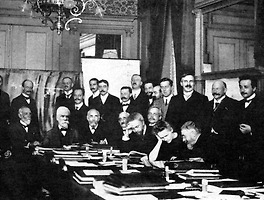
P. Debye, M. Knudsen, W.L. Bragg, H.A. Kramers, P.A.M. Dirac, A.H. Compton, L. de Broglie, M. Born, N. Bohr;
I. Langmuir, M. Planck, M. Curie, H.A. Lorentz, A. Einstein, P. Langevin, Ch. E. Guye, C.T.R. Wilson, O.W. Richardson
The International Solvay Institutes for Physics and Chemistry, located in Brussels, were founded by the Belgian industrialist Ernest Solvay in 1912, following the historic invitation-only 1911 Conseil Solvay, the first world physics conference. The Institutes coordinate conferences, workshops, seminars, and colloquia.
Following the initial success of 1911, the Solvay Conferences (Conseils Solvay) have been devoted to outstanding preeminent open problems in both physics and chemistry. The usual schedule is every three years, but there have been larger gaps.
Fifth conferencePerhaps the most famous conference was the October 1927 Fifth Solvay International Conference on Electrons and Photons, where the world's most notable physicists met to discuss the newly formulated quantum theory. The leading figures were Albert Einstein and Niels Bohr. Einstein, disenchanted with Heisenberg's "Uncertainty Principle," remarked "God does not play dice." Bohr replied, "Einstein, stop telling God what to do." (See Bohr-Einstein debates.) Seventeen of the twenty-nine attendees were or became Nobel Prize winners, including Marie Curie, who alone among them, had won Nobel Prizes in two separate scientific disciplines.
출처 : 위키피디아물리, 화학학도라면 한번쯤 이름을 들어봤을 분들입니다. 진심으로 존경합니다.
A. Piccard/피카르 - 스위스 물리학자, 심해권, 성층권 기구.
E. Henriot/앙리오 - 프랑스 화학자, 칼륨과 루비듐의 천연방사성(naturally radioactive) 정의, 전기현미경(TEM 등)의 원리제시
P. Ehrenfest/에렌페스트 - 양자물리학의 Ehrenfest's Theorem, 에렌페스트 역설, 에렌페스트 정리
Ed. Herzen/헤르젠 - 집적회로
Th. De Donder/드 동데르 - 통계역학 비가역과정의 선구자, 비가역과정의 열역학(thermodynamics of irreversible processes) 정의
E. Schrodinger/에르빈 슈뢰딩거 - 너무나 유명한 슈뢰딩거의 고양이, 슈뢰딩거 방정식
E.Verschaffelt/ - 설명 없음.
W. Pauli/볼프강 파울리 - 파울리의 배타원리
W. Heisenberg - 하이젠베르크의 불확정성 원리
R.H.Fowler/파울러 - 다윈-파울러 방법(물리화학에서의 통계역학적 원리)
L.Brillouin/브릴루앙 - 고체물리학의 Brillouin Zone
P. Debye/디바이 - 전기 쌍극자의 단위인 디바이, 디바이 길이, 디바이 함수
M. Knudsen/크누젠 - kinetic-molecular theory, 크누센 게이지(gases)등 분자 운동연구
W. Bragg/브래그 - 브래그 공식(브래그 회절, 브래그 평면)
H.A.Kramers/크라머스(크래머) - 크라머스/크로니히의 방법
P. A. M. Dirac/디랙 - 디랙의 방정식, 디랙의 바다
A. H. Compton/콤프턴 - 콤프턴 효과, 콤프턴 계수, 중성자의 발견자.
L. De Broglie/드 브로이 - 물질파의 개념을 최초로 주장해 노벨상을 수상
M. Born/막스 보른 - 파동함수의 확률론적 해석을 최초로 주장한 사람, 보른의 근사(approximate)
N. Bohr/닐스 보어 - 보어의 원자모형
I. Langmuir/랭뮤어(랭뮈어) - 플라즈마, 랭뮤어 증명
M. Planck/M. 막스 플랑크 - 플랑크 상수, 양자 역학. 플랑크 가설
M. Curie/마리 퀴리 부인 - 유일한 여성 노벨상 2관왕, 퀴리온도, 방사성 원소 발견
H. A. Lorentz/로렌츠 - 특수상대론의 로렌츠 변환(transofomation), 로렌츠 법칙
A. Einstein/알베르트 아인슈타인 - 브라운 운동, 광전 효과, 상대성 이론
P.Langevin/랑주뱅 - 고전역학의 Langevin dynamics, 랑주뱅 방정식
Ch.E.Guye/구에 - 아인슈타인 선생님
C. T. R. Wilson/C.T.R. 윌슨 - 윌슨의 안개상자.
O. W. Richardson/리처드슨 - 열이온의 리처드슨의 법칙, 광전효과(photoelectric effect), 지자기효과(photoelectric effect)
'Physics' 카테고리의 다른 글
| [펌] 수리물리학 참고 서적 소개 (0) | 2009.08.06 |
|---|---|
| [펌] 양자역학 참고 서적 소개 (0) | 2009.08.06 |
| Taylor series - 테일러 급수전개 (0) | 2009.03.13 |
| [펌] 물리교재 소개2 (0) | 2009.01.19 |
| [펌] 물리교재 소개 (2) | 2009.01.19 |
| Solvay Conferences (0) | 2008.11.22 |
| Bragg's Law (0) | 2008.09.21 |
| 고체물리학, 결정구조 (1) | 2008.09.02 |
| Commutation Relations (1) | 2008.04.01 |
| 자유낙하운동 (0) | 2007.01.18 |



